An incredible 12-day journey of discovery in Zambezi began with driving from the source of the mighty Zambezi River to Victoria falls, one of the seven natural wonders.
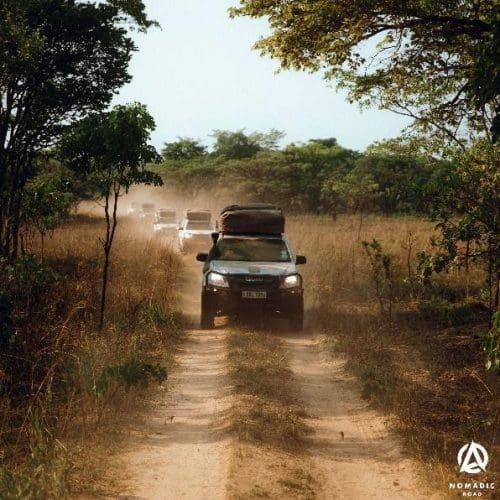
Woke up in the middle of the night to the sound of a thunderstorm and heavy rains, unsure of where I am but nevertheless felt very calm. Took me a while to realise that I am in a car rooftop tent, next to a pond probably infested with crocodiles in Liuwa National Park in Zambia, Africa.
The bushes below were swarming of big black ants which would creep up pants and bite deep into the flesh and we were told they can eat any living thing. Despite all this, Tom our guide and a professional hunter felt this is a safe place to camp for the night in spite of all this I felt at ease.
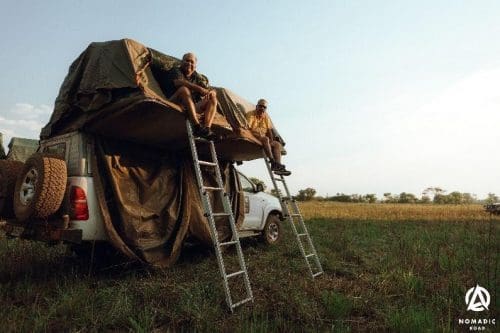
Toyota Hilux’s specially modified with rooftop tents
What woke me up was a very intense need to attend to the call of nature (No.1) and the fact that I can’t conjure up the strength to climb down the stairs do my business in the dark, surrounded by bushes and occasional shrieks of hyenas and grunts of a boar. I was up for about 45 mins and explored all options – a bottle, waking up others, lighting up the ground but finally settled for doing it standing up on top of the stairs.
Early morning, we saw the tribal chief visiting us and Tom paid his respects by walking on his knees and clapping his hands while having his eyes to the ground all this before he signed his book of visitors.
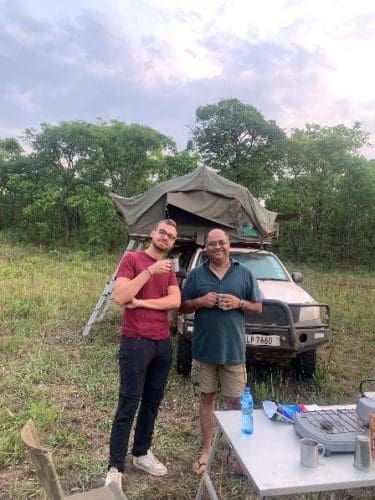
With Charles
A cup of masala chai with Charles (our official French videographer) a few minutes later was perfect to share what happened during the night.
A few weeks back, Venky of Nomadic Road reached out saying a slot has opened up in the Zambia self-driving expedition with 12 members plus crew and if I will like to join it.
I instantly said yes as me and my son did Mt. Everest base camp in Tibet with him and knew it will be awesome. This was a promising 12-day driving from the source of the mighty Zambezi River to Victoria falls, one of the seven natural wonders. My fellow explorers and crew turned out to be a crazy mix of personalities from India, Dubai, and Europe.
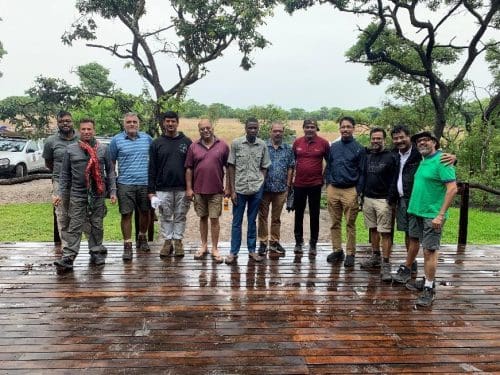
Fellow explorers and crew
Few were 60+ but most were adventurous (read Bungie jumping) and some were the best Samaritans I have ever met. Two Swiss amongst us would be subjected to extreme culture shock interacting with Indians and Africans but then we all wear Swiss watches to blame for the IST (read delays every time).
But all of us have immense love for the road and will do anything for a crazy drive that we were about to embark on. This was evident in the dinner banter on the eve of the expedition in Lusaka after inspecting the Toyota Hilux’s specially modified with rooftop tents, highly efficient food freezers, and filled with ice, water, snacks, and other needs for the next 12 days.
In the first few days of our travel, I noticed a very thick population of very tall, terracotta-colored pyramid-shaped ant hills. Some were more than 15 feet wide and 20 feet tall. Tom’s very elaborate and eye-popping and jaw-dropping answer to my simple question over walkie-talkie – What’s the significance of these anthills Tom?
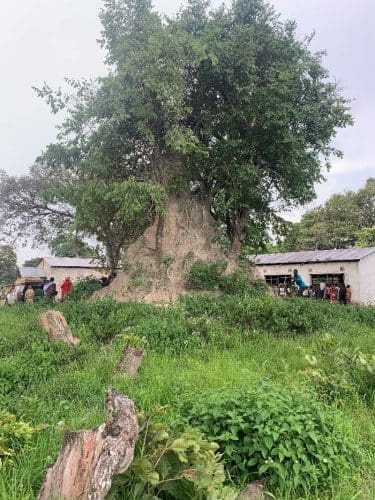
Turns out these were the abode of white ants or termites and contrary to popular belief, they do not eat wood. The termites are extremely organised colonies led by a queen who reigns for over 30 years before passing the baton to 2 more queens after which the whole colony dies taking the total span for the colony to approx. 100 years.
The gatherers among the ants collect dead bark, leaves, etc, and carry them to the hills. These are then stored at a specific temperature effected by dew carefully selected and carried into these chambers which helps fungus growth and then a white mould on top appears which is the food for the ant.
The temperature is so well maintained that snakes and water monitors leave their eggs to mature. I wonder why nature chooses monarchy in communities like Ants. Why do we want democracy to work for us or are we going wrong?
Zambia is home to more than 70 languages and 100+ tribes. Most live in villages and everyone exuded warmth to our 8-vehicle caravan.
We all had decided to add “cause” to our travel and Shannon (Caravan’s mother cooking and keeping all of us sane) identified a village school that needed help.
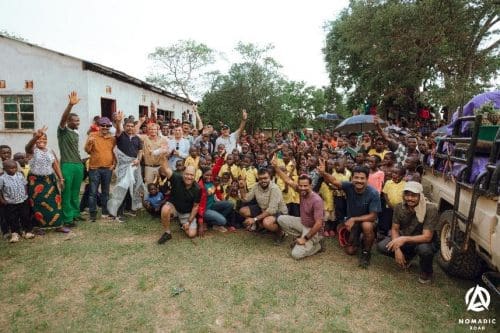
Adding a good “cause” to our travel – helping a local school
It was embarrassing to see how the entire village turned out to applaud our small gesture of help. The ceremony included songs, dances, poems, and a traditional offering of the choicest buckets of pineapples. We left feeling humbled and wanting to do much more.
Tom our guide and hunter keeps sending us pictures of how the school is developing warming our hearts every time.
Zambezi is the 4th longest river in Africa starting as a puddle and spreading prosperity as it winds down through 8 countries and 2400 km and becomes mightier by the kilometre.
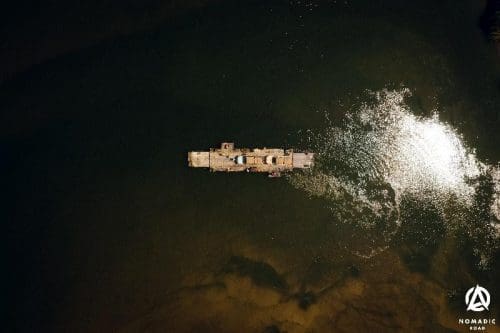
We crossed it with our 4×4 vehicles by modern bridges and ancient rope-pulled pontoons. Some of us got stranded in the middle of the river on the pontoon for 3 hours due to a shortage of diesel and one of the pontoons was being pulled by men reminding us of life much before the cell phone era.
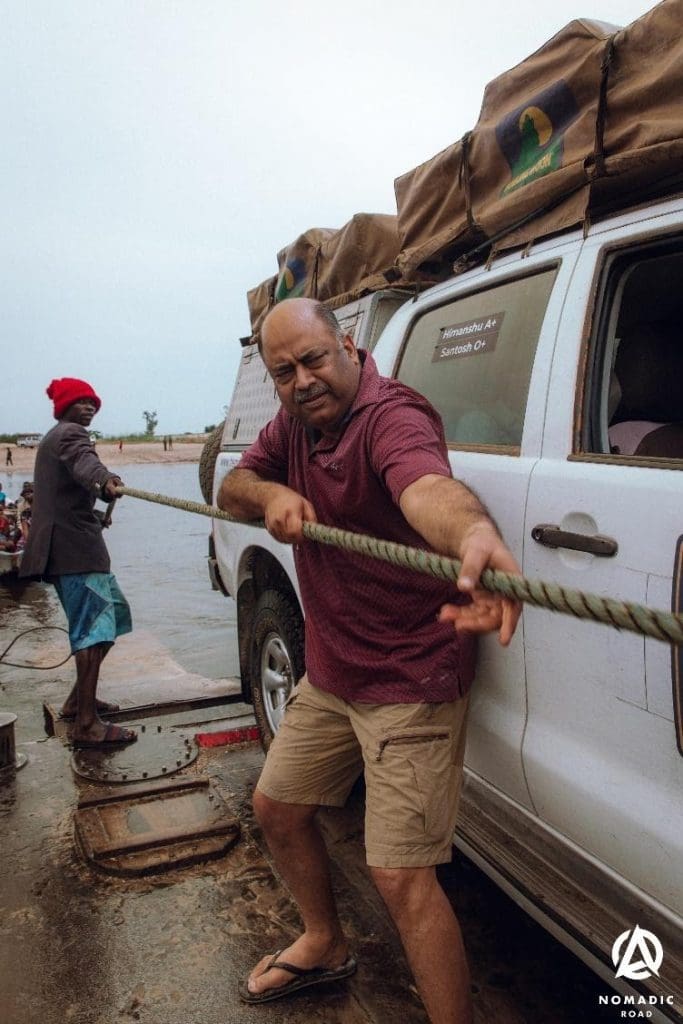
The trip was taking us outside of our comfort zone in more ways than one. Almost all nights we either slept in car rooftop tents or hut-like rooms in bushes.
One thing we learned is that except for polar bears and crocs, no other animal treats humans as food unless they are made to attack. It was a relief but also felt a little disappointed too of our uselessness to nature. The rooms were no protection from Hippos grazing nearby out of the water at night or leopards roaming around for food and water.
The whole country reminded us of how civilization must have evolved. Despite cooking gas availability, everyone loves cooking using charcoal and we saw villagers burning trees to convert to coal and selling sacks of it on the roadside.
In addition to charcoal, we saw villagers selling extremely tasty honey, berries, mangoes, and much more on the roadside. Some of the conversations with the sellers revealed their fluency in English probably a gift from the British occupancy. It was such a delight to learn how they overthrew the British in less than 50 years and used stones only. The towns were mostly dusty, with little or no traffic, handwritten shop banners, and colourful local bazaars and shops.
Charlie aged 25, our excellent French photographer for the expedition expertly used his drone camera to locate the best camping site for a few nights. Driving off-road for 1/2 km away from civilisation into the wilderness was scary for an ex-corporate guy like me. Tom picked a place half surrounded by trees and rest extended into plains with visibility of several km.
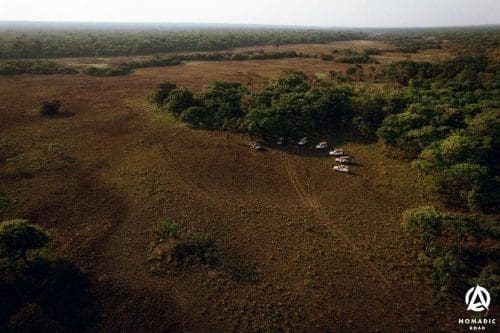
Best camping site
Setting up our tents on top of our cars was quite a feat and then I saw Tom and Shannon disappearing into bushes as the sun was going down. I later learned they went to take a bath in a nearby river which made me shudder with fear and envy of how close they are to nature. This would be repeated many times during the expedition and every night spent in the tents was a peaceful bliss. We are blessed as John Kulombo, a young man from local tribes, drove in our car during the entire trip.
I constantly asked him questions about his village life and wondered how their traditions and culture were similar to our Hindu way of life. Not surprisingly both are pretty similar as both are ancient and born out of understanding life and environment.
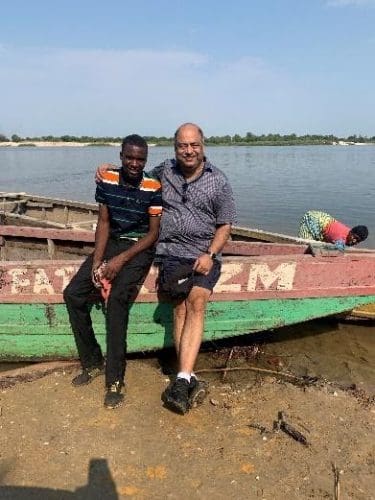
With John Kulombo
No deity except for rivers, trees, and stones. Eating with hands and sleeping on the floor. Rituals marking life and seasonal events. Details worthy of a book perhaps someday. We developed a huge respect for each other, and he fondly named me prof and I am very proud of that. John a few days back shared his Uni admission letter, and I am extremely proud of him.
We got an opportunity to spend some time in a village next to the main road. Most villages are spread over a large area with a tree as a centre. A large woman in her mid-fifties seemed to be in charge of having lunch under the village, graciously allowed inside their lives and homes. A large girl’s room, a few huts inside a boundary wall were meant for males, females, and the kitchen.
A grain storage and shelter for cows, goats, and chickens were an integral part of their home. The bathroom was a little aloof of course. Most villages and Zambian towns were extremely clean. About 100 ft away a similar set of huts were her father’s home.
Interestingly, most villages in the south and eastern part of Zambia had an Anthill in the centre of the village. A casual inquiry to a villager as to why they have an anthill left them confused and said Well! we get bricks for our homes. They could not fathom why they should destroy ants’ adobe. The mud from the anthill makes for very strong bricks for the houses and ants repair the broken hill in a few days.
The expedition true to nature had its surprises. Shortage of fuel, meals consisting of what Shannon could put together to feed 18 people 3 times a day and long nights filled with a lot of alcohol, friendly banter, and recounting the day over bonfire lit by Tom.
There were lunches on the roadside with village kids overlooking us consisting of pasta prepared by the Swiss, packed lunches next to Hippos Pond, and at times burgers while driving. Swiss and French repeating Hindi abuses were a source of laugh riot every time.
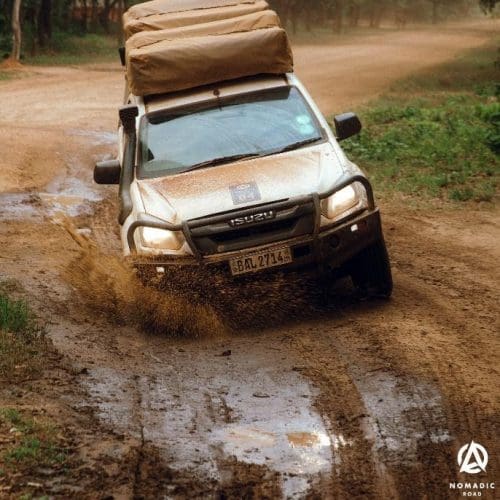
Toyota Hilux & Isuzu’s turned out to be beasts on the track
Toyota Hilux & Isuzu’s turned out to be beasts carrying dizzying amounts of goods, but many a time gave way to continued abuse by the lack of roads and prolonged use of H4 and L4. With the rainy season about to begin, most of Zambia has trees laden with mangoes in though not ripe yet which was a bit of a disappointment for mango lover Indians like me. But the drinking, the dancing, and eating at the end of the day made everything worth it.
Venky brought us back to luxury slowly to avoid rude shocks and we first landed in Livingstone, the party capital of Zambia. Extreme sports in the gorges of Victoria Falls, Indian food after 13 days, and hotel rooms with laundry.
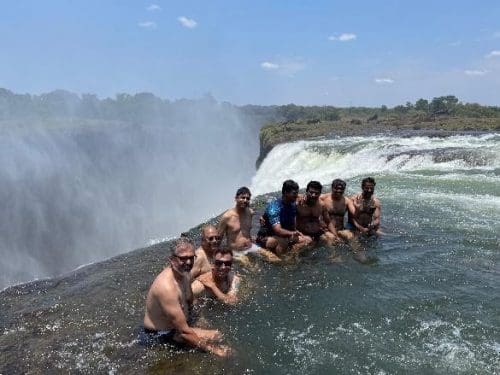
Dip in the Devil’s Pool
Earned bragging rights with family and friends by taking a dip in the Devil’s Pool on the edge of the 400 ft falls and chopper ride touching water deep in the gorges.
All this before we reached Lusaka in the very familiar 5-star luxury and a shopping trip to a cultural village. A pit stop at Taj’s Indian restaurant for lunch with several Indian dishes selected by chef Nitin was a big bonus.
An African travelogue isn’t complete without some spectacular pictures of wildlife and so here are a few from Zambia expedition. A visual treat by Julien Fabro Nomadic Road’s videographer for the next expedition after ours.
All in all, staying in the wilderness, one with nature, crickets chirping at night putting you to sleep, and waking up to the sound of water or rains. Learning and understanding African tribal culture and finding similarities to our own was reassuring in some sense.
All this takes you millions of miles away from worldly worries and calmness descends on you making you live in the moment and full of strength and courage you never knew you had and full of new life skills in the end at the ripe age of 54.
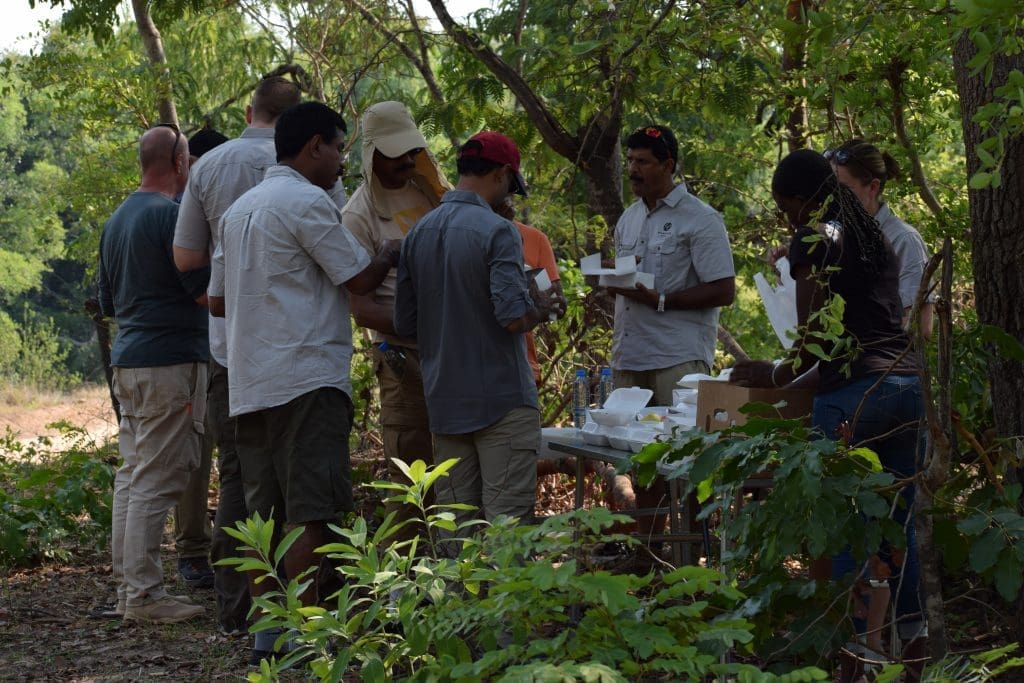
Friends and food
(Himanshu Goel is a business leader with over three decades of experience with organizations like IBM, Microsoft & Cisco. He is also an angel investor in upcoming technology-led software startups. His love for the road takes him to offbeat destinations in self-driving expeditions in domestic and international locations.)
Read More: Latest



